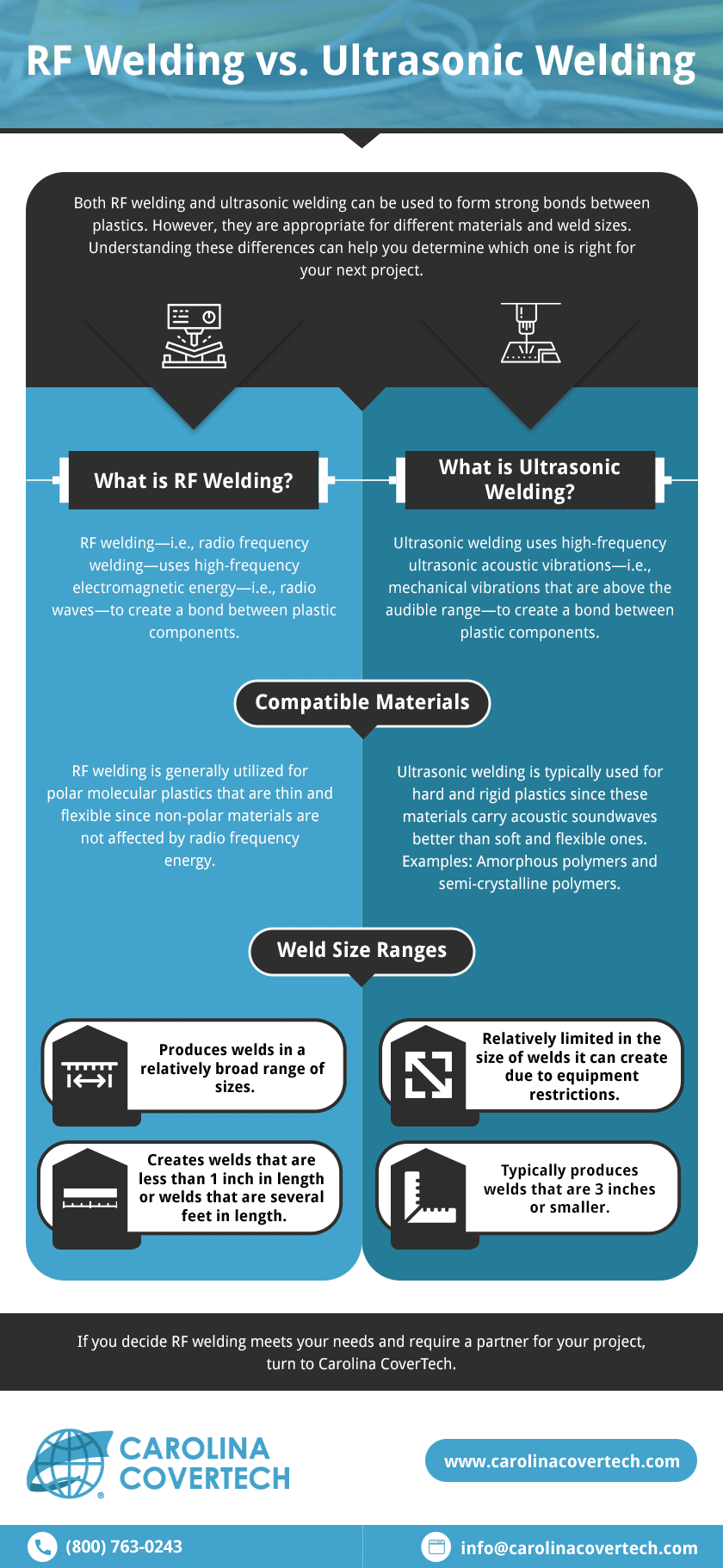RF Welding vs. Ultrasonic Welding
Leave a CommentTwo commonly utilized methods of plastic welding are RF welding and ultrasonic welding. While both processes utilize heat and pressure to create a strong bond, they achieve them in slightly different ways. These differences can make them suitable for distinct applications. That’s why it is important to understand them before you choose a plastic welding solution for your project.
Below, we provide an overview of RF welding and ultrasonic welding. It discusses what they are and highlights the key differences between them to help readers identify which process is right for their needs.
What Is RF Welding?
RF welding—i.e., radio frequency welding—uses high-frequency electromagnetic energy—i.e., radio waves—to create a bond between plastic components. The energy causes the molecules within the materials to vibrate at faster speeds, which generates heat. The heat melts the materials, enabling them to be fused when pressed together and allowed to cool.
What Is Ultrasonic Welding?
Ultrasonic welding uses high-frequency ultrasonic acoustic vibrations—i.e., mechanical vibrations that are above the audible range—to create a bond between plastic components. The vibrations are produced by a welding sonotrode and applied at the joint line of pieces held together under pressure. This process generates friction and, consequently, heat, which melts the materials, enabling them to fuse together as they cool.
Ultrasonic vs. RF Welding
Initially, ultrasonic welding and RF welding seem highly similar. For example, the two processes produce strong and durable bonds between plastics quickly and cleanly. Additionally, both are energy efficient and eco-friendly. However, when you look at compatible materials and weld size ranges, it is clear they are different enough from each other that they may be used for different applications.
- Compatible materials: Ultrasonic welding is typically used for hard and rigid plastics since these materials carry acoustic soundwaves better than soft and flexible ones. Examples include amorphous polymers and semi-crystalline polymers. RF welding is generally utilized for polar molecular plastics that are thin and flexible since non-polar materials are not affected by radio frequency energy.
- Weld size ranges: Ultrasonic welding is relatively limited in the size of welds it can create due to equipment restrictions. Typically it produces welds that are 3 inches or smaller. RF welding can produce welds in a relatively broad range of sizes. It can create welds that are less than 1 inch in length or welds that are several feet in length.
While the above differences make ultrasonic welding and RF welding suitable for different applications, they are used within some of the same industries. Ultrasonic welding is commonly used in the following industries: appliances, automotive, electronics, medical, packaging, textiles, and toys. RF welding is frequently used in the following industries: automotive, aviation, construction, medical, military, packaging, recreation, and transportation.
RF Welding Solutions From Carolina CoverTech
Both RF welding and ultrasonic welding can be used to form strong bonds between plastics. However, they are appropriate for different materials and weld sizes. Understanding these differences can help you determine which one is right for your next project.
If you decide RF welding meets your needs and require a partner for your project, turn to Carolina CoverTech. As leaders within the RF welding industry, we have the knowledge, skills, and tools to deliver high-quality RF welded components and assemblies tailored to your requirements and restrictions. To learn more about our capabilities or discuss your project with one of our team members, contact us today.

